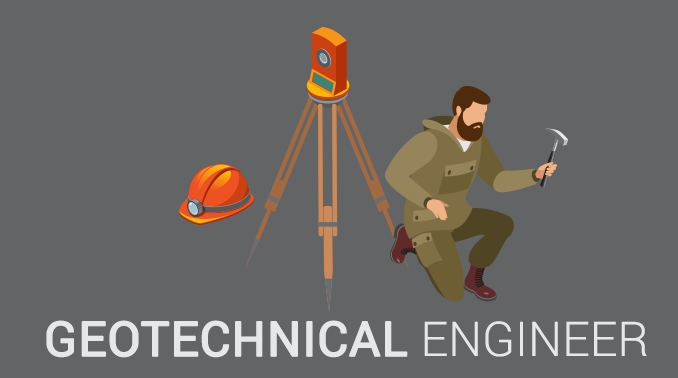Geotheta Fundamentals Explained
Geotheta Fundamentals Explained
Blog Article
Geotheta for Beginners
Table of ContentsThe Best Strategy To Use For GeothetaRumored Buzz on GeothetaGetting The Geotheta To WorkSome Known Factual Statements About Geotheta The Main Principles Of Geotheta

They carry out site examinations, gather examples, perform laboratory examinations, and analyze data to review the suitability of the ground for building jobs - Consulting Engineer. Based upon their findings, geotechnical designers provide referrals for structure design, incline stability, preserving frameworks, and reduction of geotechnical threats. They team up with various other professionals, such as designers, structural engineers, and building and construction groups, to ensure that geotechnical considerations are incorporated right into the total task layout and application
By assessing the behavior and buildings of dirt and rock, they can determine prospective geotechnical risks such as landslides, soil settlement, or incline instability. Their expertise aids stop failings or crashes that can threaten lives and building. Below are some thorough responsibilities and obligations of a geotechnical designer: Site Investigation: Geotechnical designers conduct website examinations to collect information on subsurface problems.
They interpret the data to comprehend the residential or commercial properties and behavior of the soil and rock, including their strength, permeability, compaction qualities, and groundwater conditions. Geotechnical Analysis and Design: Geotechnical designers evaluate the information accumulated throughout site investigations to analyze the stability and viability of the website for construction projects. They perform geotechnical calculations and modeling to assess factors such as bearing capacity, negotiation, incline stability, lateral earth stress, and groundwater flow.
Things about Geotheta
Foundation Layout: Geotechnical designers play an essential function in developing foundations that can securely support the desired framework. They evaluate the dirt conditions and load needs to identify the suitable structure type, such as shallow structures (e.g., grounds), deep foundations (e.g (https://pxhere.com/en/photographer/4325446)., stacks), or specialized techniques like dirt renovation. They think about elements such as settlement limits, birthing capability, and soil-structure interaction to create ideal foundation layouts
They evaluate construction strategies, screen website tasks, and perform area assessments to confirm that the style suggestions are followed. If unforeseen geotechnical concerns arise, they analyze the scenario and give referrals for remediation or changes to the style. Risk Analysis and Reduction: Geotechnical engineers analyze geotechnical dangers and threats related to the job site, such as landslides, liquefaction, or dirt erosion.

Cooperation and Interaction: Geotechnical designers work closely with various other professionals associated with a job, such as engineers, structural engineers, and building and construction groups. Reliable interaction and cooperation are vital to incorporate geotechnical factors to consider into the general project layout and building process. Geotechnical designers offer technical expertise, response queries, and make certain that geotechnical demands are fulfilled.
The Ultimate Guide To Geotheta
Here are some sorts of geotechnical designers: Structure Designer: Structure engineers concentrate on making and evaluating structures for frameworks. They assess the soil problems, load requirements, and website characteristics to identify one of the most appropriate foundation type and style, such as shallow structures, deep foundations, or specialized techniques like stack foundations.
They examine the factors influencing slope stability, such as soil homes, groundwater conditions, and incline geometry, and establish methods to avoid incline failings and alleviate threats. Quake Designer: Quake engineers specialize in analyzing and designing frameworks to hold up against seismic pressures. They examine the seismic danger of a website, assess soil liquefaction possibility, and create seismic style requirements to guarantee the security and resilience of structures during earthquakes.
They perform area testing, accumulate examples, and examine the gathered information to identify the soil properties, geologic developments, and groundwater problems at a website. Geotechnical Instrumentation Engineer: Geotechnical instrumentation designers focus on monitoring and measuring the actions of dirt, rock, and frameworks. They install and maintain instrumentation systems that keep an eye on elements such as dirt negotiation, groundwater degrees, slope activities, and architectural displacements to analyze efficiency and offer early cautions of prospective issues.
5 Simple Techniques For Geotheta
They perform examinations such as triaxial tests, loan consolidation tests, straight shear examinations, and permeability tests to collect data for geotechnical evaluation and layout. Geosynthetics Engineer: Geosynthetics engineers focus on the layout and application of geosynthetic materials, such as geotextiles, geogrids, and geomembranes. They use these materials to boost dirt security, reinforce slopes, offer water drainage solutions, and control disintegration.
They tend to be investigative people, which suggests they're intellectual, introspective, and inquisitive. They are curious, methodical, reasonable, logical, and rational. Several of them are likewise social, implying they're kind, generous, participating, client, caring, helpful, empathetic, tactful, and friendly. Does this seem like you? Take our totally free occupation examination to discover if geotechnical engineer is just one of your leading career matches.
In the office setting, geotechnical designers make use of specialized software program tools to carry out estimations, develop designs, and analyze information. They prepare reports, review task specs, interact with clients and staff member, and coordinate job tasks. The workplace setting provides a helpful setting for study, evaluation, and cooperation with other specialists associated with the job.
Geotheta Can Be Fun For Anyone
They often visit project websites to conduct site examinations, analyze geotechnical conditions, and gather data for analysis. These gos to include traveling to various places, often in remote or challenging surfaces. Geotechnical designers may execute soil tasting, conduct tests, and display building and construction activities to make certain that the geotechnical aspects of the job are being implemented properly.
Geotechnical engineers also operate in specialized geotechnical research laboratories. In these centers, they carry out experiments, carry out tests on dirt and visit rock examples, and assess the design homes of the materials. Geotechnical lab designers work extensively in these settings, taking care of testing tools, running tools, and recording data. They team up with other laboratory team to make sure accurate and dependable testing outcomes.
Report this page